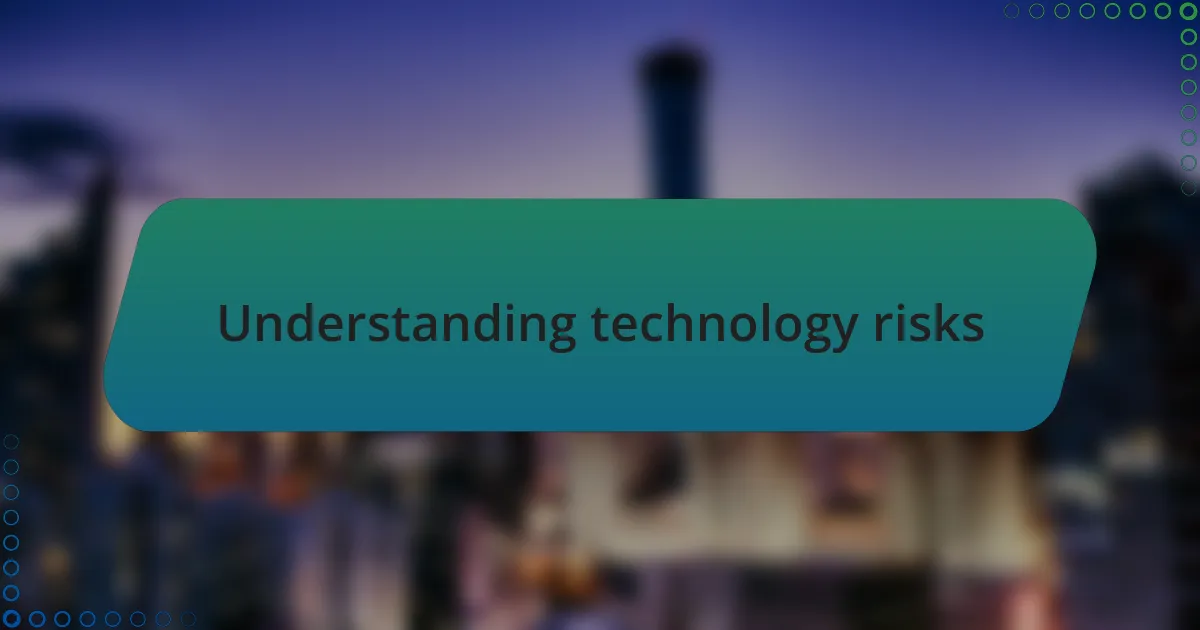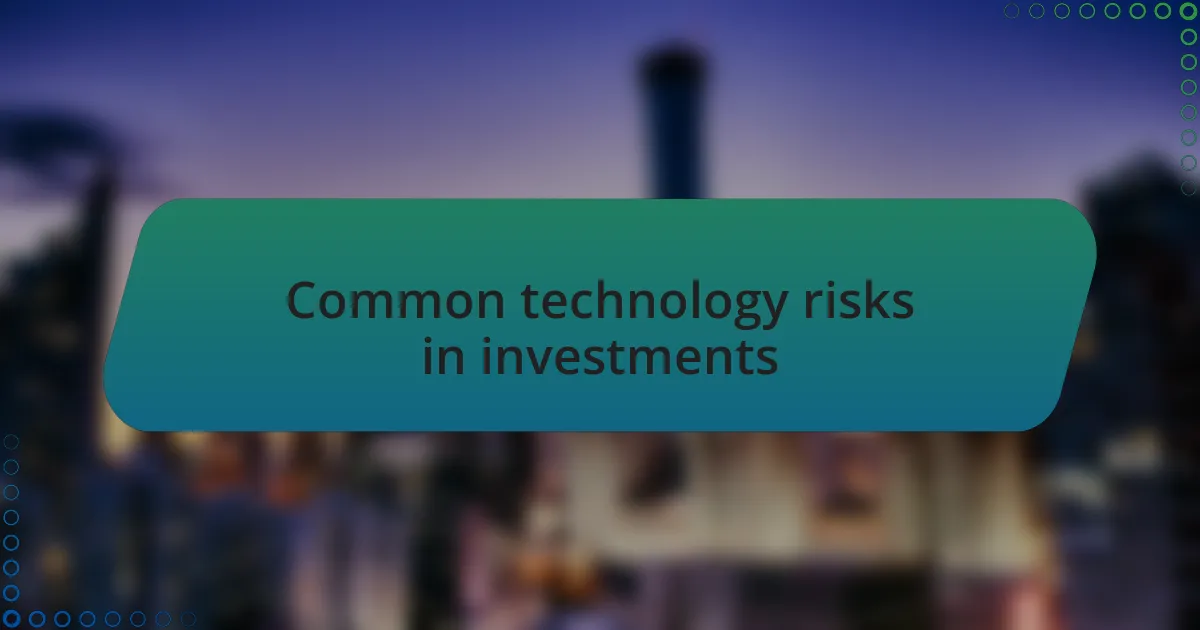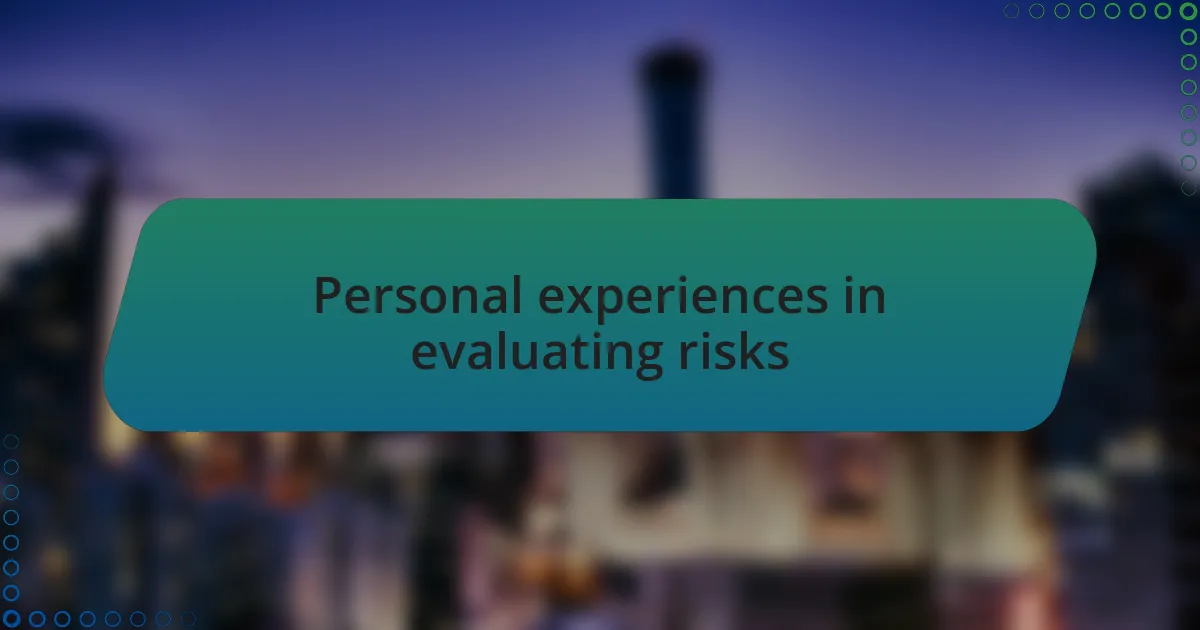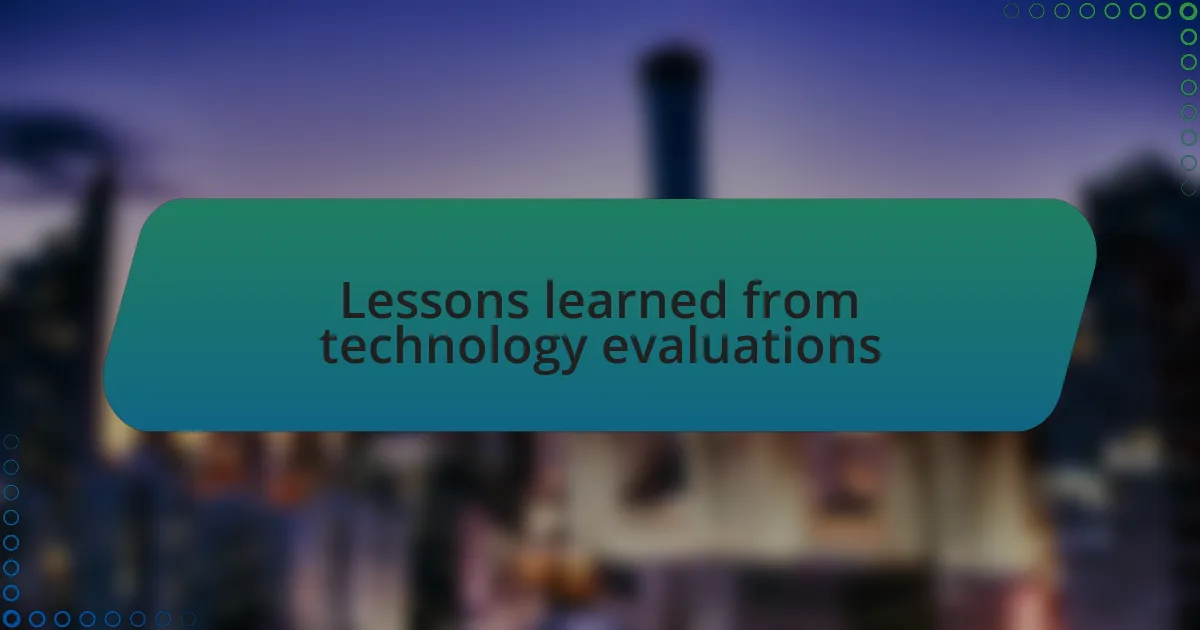Key takeaways:
- Understanding technology risks requires a proactive approach to identifying vulnerabilities and fostering a culture of vigilance within teams.
- Neglecting technology risks can lead to significant consequences, including financial loss, damaged reputations, and team morale issues.
- Regular assessments, audits, and stakeholder engagement are crucial for uncovering hidden risks and ensuring effective risk management strategies.
- Lessons learned emphasize the importance of documentation, stakeholder input, and the value of intuition in risk evaluation processes.

Understanding technology risks
Understanding technology risks involves recognizing the potential vulnerabilities that can disrupt business operations or compromise sensitive data. When I first delved into this realm, I was struck by how a simple misconfiguration could lead to a significant breach, something that can happen to anyone, regardless of size or industry. Have you ever considered how often we overlook the nuances of our technology setups in favor of shiny new features?
I remember a project where we relied heavily on cloud-based services without fully grasping the implications of data privacy policies. The anxiety that followed as we navigated compliance requirements was a serious wake-up call. This experience underscored for me that understanding technology risks isn’t just about identifying potential threats; it’s also about fostering a culture of vigilance and adaptability within an organization.
Moreover, technology risks extend beyond just technical issues; they intertwine with human factors and decision-making processes. Every time a new software is introduced, I ask myself: how does this affect our workflow and our team’s ability to perform effectively? Creating a robust risk assessment strategy requires ongoing dialogue about these critical questions, as the landscape of technology continues to evolve rapidly.

Importance of evaluating technology risks
Evaluating technology risks is essential for safeguarding both assets and reputation. I recall a situation where a firm underestimated the importance of cybersecurity measures, thinking their systems were too small to attract attention. Unfortunately, that belief was shattered when they faced a ransomware attack, which not only cost them financially but severely damaged their credibility. Isn’t it fascinating how a single decision can ripple through an organization, affecting everything from employee morale to client trust?
The implications of neglecting technology risks can be vast and profound. I once attended a seminar on risk management where a speaker shared the harrowing story of a startup that lost crucial data due to an unrecognized vulnerability in their software. The emotional toll on the team was palpable as they scrambled to recover lost work. This experience highlighted the reality that the stakes are high; evaluating risks proactively can save a company from heartbreak and chaos down the line.
A systematic approach to evaluating technology risks also fosters strategic decision-making. For instance, when I take on new projects, I always conduct a thorough risk assessment to identify any hidden challenges before they arise. I often wonder, how can we create innovative solutions if we’re shackled by preventable risks? By prioritizing risk evaluation, we empower ourselves to innovate confidently, knowing that we’ve considered the potential dangers along the way.

Common technology risks in investments
Technology risks in investments can manifest in several forms, and one of the most prevalent is data security breaches. I remember a decision I made once where we opted for a cloud storage solution without properly vetting the provider’s security protocols. Shortly after, headlines broke about significant data leaks affecting providers we’d considered. That made me realize how crucial it is to scrutinize the technologies we entrust with sensitive information—lack of diligence can lead to not just financial loss but also loss of trust from clients and stakeholders.
Another risk that often goes unnoticed is system downtime. Early in my consulting career, I worked with a firm that heavily relied on outdated software for trading operations. We experienced unexpected outages, and I felt the panic in the room as traders lost valuable opportunities. This situation underscored the importance of ensuring that technology infrastructure is modern, reliable, and able to withstand pressure. Isn’t it unsettling how something as simple as an outdated system can derail a carefully planned investment strategy?
Lastly, integration risks arise when new technologies are adopted without ensuring compatibility with existing systems. I recall advising a company that merged two different platforms, only to find that their data silos created chaos. I could see the frustration on their faces as they struggled to reconcile discrepancies, which not only slowed down operations but also sapped team morale. If only we had considered the ramifications in advance—wouldn’t it have saved us from that turmoil? A thorough evaluation of technology risks is not merely a best practice; it is a necessity for sustainable success in investment consulting.

Methods for assessing technology risks
Assessing technology risks involves various methods, and one effective approach is the use of risk assessments frameworks. I’ve found that frameworks like FAIR (Factor Analysis of Information Risk) provide a structured way to identify and quantify risks. When I first applied this method in a client project, it transformed how we prioritized our security initiatives, helping us gain clarity and focus on the most pressing vulnerabilities. Isn’t it fascinating how a systematic approach can make complex risks seem more manageable?
Another method I swear by is conducting regular technology audits. I remember a time when a routine audit revealed overlooked security gaps in our data management practices. The team’s surprise turned into a concerted effort to educate ourselves about these gaps, ultimately enhancing our overall security posture. How often do we assume everything is fine without taking a step back to inspect the inner workings? Regular audits can shed light on areas we might otherwise neglect.
Stakeholder interviews also play a crucial role in assessing technology risks. Engaging with team members across different levels helps uncover insights that often escape a top-down perspective. In one instance, after speaking with frontline employees, we discovered their concerns about a new software tool’s usability—an issue that could have led to significant disruptions otherwise. How valuable is it to hear firsthand experiences that reveal the real operational landscape? By listening to those on the ground, we can identify risks that might not be evident in reports or data alone.

Tools for technology risk evaluation
Tools for technology risk evaluation are essential for turning abstract concerns into concrete strategies. One tool I’ve found particularly useful is the risk management software suite known as LogicManager. When I first integrated it into my workflow, I was amazed at how it centralized data from various sources, allowing for a more cohesive understanding of our risk landscape. Have you ever wished for a clearer picture of your overall exposure? LogicManager made that happen for us, simplifying complex elements into actionable insights.
Another approach I’ve come to rely on is threat modeling, using tools like STRIDE. This technique systematically identifies potential vulnerabilities in systems based on various threat types. I recall a project where we applied STRIDE and uncovered several overlooked threats, leading to immediate changes in our development process. Isn’t it empowering to take proactive steps that not only identify risks but also educate your team about the potential dangers lurking in their designs?
Finally, I can’t overlook the value of scenario analysis tools, such as Scenario Wizard. In one project, we simulated various cyber-attack scenarios to gauge our response capabilities. This not only prepared the team for real-life incidents but also fostered a deeper understanding of our existing vulnerabilities. I have to ask, how often do we simulate worst-case scenarios? Engaging with these tools can be enlightening, pushing us to think beyond standard protocols and truly prepare for the unexpected.

Personal experiences in evaluating risks
Evaluating risks has often felt like navigating a maze. I remember a particularly challenging instance when our team faced a potential data breach during a major project. I collaborated closely with IT to scrutinize our existing protocols, and the tension in the room was palpable as we sifted through countless variables and possible points of failure. In those moments, I’ve learned that keeping a level head and fostering open communication can lead to clarity, even in chaos.
There’s an emotional weight that comes with assessing risks, especially when there’s a lot at stake. During a late-night brainstorming session, I shared my concerns about integrating a new technology that seemed promising on the surface but carried unknown complexities. The decision to proceed felt almost like a leap of faith. But having the conversation, listening to diverse perspectives, and reflecting on past experiences helped us navigate that uncertainty with more confidence.
What truly struck me about evaluating risks was the realization that it’s not just a technical exercise; it’s a deeply human one. I once facilitated a team workshop focused on risk communication where participants shared past mistakes that led to costly oversights. The vulnerability displayed during those discussions transformed our approach to risk evaluation, fostering a culture where asking questions isn’t just welcomed—it’s essential. Isn’t it fascinating how sharing experiences can turn fear into an opportunity for growth?

Lessons learned from technology evaluations
Evaluating technology risks has taught me the critical importance of thorough documentation. I remember a project where insufficient records led us to overlook a key vulnerability that later caused delays. This experience reinforced my belief that clear, concise documentation not only streamlines communication but also acts as a safety net during evaluations. How often do we dismiss the mundane, only to find it was the key all along?
In another instance, I worked with a startup that rushed to implement a cutting-edge software solution. Initially, the excitement blinded the team to potential shortcomings. The aftermath taught us that gathering input from various stakeholders early in the process can surface hidden concerns. Isn’t it interesting how the most innovative ideas can come with blind spots that we might overlook if we move too fast?
One lesson I cherish is that risk evaluation is as much about intuition as it is about analysis. There was a time when I had a gut feeling about a vendor’s security practices, despite their impressive credentials. I decided to dig deeper, and that instinct ultimately saved us from a costly partnership. How many times have you trusted your instincts only to be proven right? It’s a reminder that our insights and experiences often hold more weight than we realize, guiding us toward informed decisions.